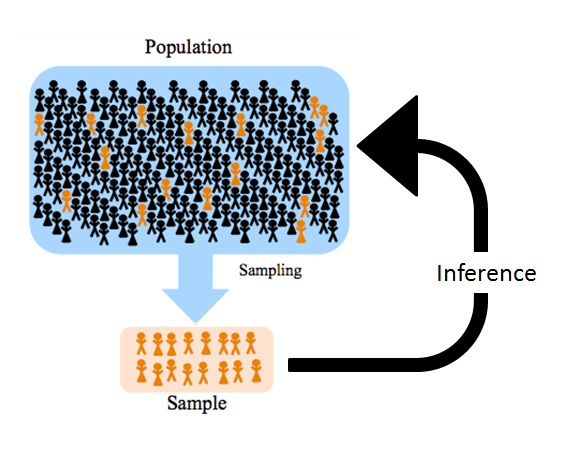Main Content
Lesson 1: Decision Making Under Uncertainty
Types of Statistics
There are two basic classifications of statistics, descriptive and inferential. Both play an integral role in the analysis of a dataset. This course will explore the basics of each one.
Descriptive Statistics
Descriptive statistics deal with the collection, summarization, and description of data. They tell us information such as:
-
- How were the sales of a new product?
- How much time do people spend on social media?
- What does it cost to ship our products to customers?
Descriptive statistics provide a concise summary of data. They can be represented graphically or numerically.
Inferential Statistics
In the previous examples, what can we say about the time women spend on Facebook each day? What can Macy's say about its customers' spending habits during the summer months? Does this properly reflect a typical woman on Facebook or a typical customer at Macy’s?
This inference helps us in decision-making down the line. Facebook can use the information about women’s browsing times to place ads that are targeted to women. Macy’s can use its summer weekend sales data to create sales targets for store managers.
What can we infer about a population's parameters based on a sample's statistics?
Statistical inference is the process of making an estimate, prediction, or decision about a population based on a sample. Inferential statistics can be categorized in two major areas: estimation and statistical testing.-

-
Estimation
-
Estimation deals with prediction. We predict the average, median, or other characteristics of the data based on past observations.
Estimation Example: What will be the average sale of the new iPhone based on past history? -
Statistical Testing
-
Testing allows us to statistically test our beliefs or conjectures about a set of data.
Testing Example: Women are more likely than men to click on an advertisement on social media.
Caution!
Statistics can easily mislead you if you do not know what to watch out for.
“There are three kinds of lies: lies, damned lies, and statistics. -Origin not known, some (probably erroneously) attributed to Mark Twain
Small Sample Size
We know that we take a subset of the population to make inferences about the population. The number of data points in the subset is known as the sample size. The bigger the sample size, the better. A study performed with a small number of observations may not provide statistically valid results (more about this in Lesson 3).
For example, take whole-body cryotherapy. This is an extreme cold treatment that is said to provide several health benefits. A 2015 Cochrane systematic review looked at studies assessing the benefits and harms of whole-body cryotherapy in preventing and treating exercise-induced muscle soreness in adults and found that the claims are based on four studies of an extremely small sample size: 64 young adults (average age of 23), 60 of whom were male. Such a small sample size brings to question the validity of the treatment’s claims. 64 young adults with an average age of 23 are not the intended population if the treatment is marketed to men and women of all ages.
Biased Sample
A biased sample, on the other hand, involves only certain parts of the population in the study and thus does not properly represent the population. Take, for example, clinical trials on cardiovascular diseases.
Cardiovascular disease is the number one killer of U.S. women, and it affects men and women differently at every level, including symptoms, risk factors and outcomes. But only one third of cardiovascular clinical trial subjects are female and only 31% of cardiovascular clinical trials that include women report results by sex. (Westervelt, 2015)
No wonder medicine often has dangerous side effects for women, and we are realizing this now!
References
McGregor, A. (2014). Why medicine often has dangerous side effects for women. TED. Retrieved from https://www.ted.com/talks/alyson_mcgregor_why_medicine_often_has_dangerous_side_effects_for_women
Westervelt, A. (2015). The medical research gender gap: How excluding women from clinical trials is hurting our health. The Guardian. Retrieved from https://www.theguardian.com/lifeandstyle/2015/apr/30/fda-clinical-trials-gender-gap-epa-nih-institute-of-medicine-cardiovascular-disease
